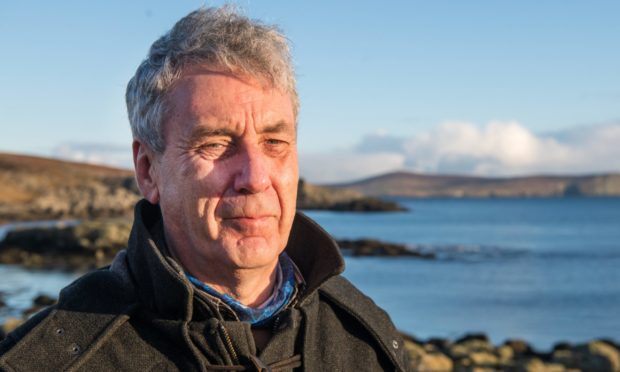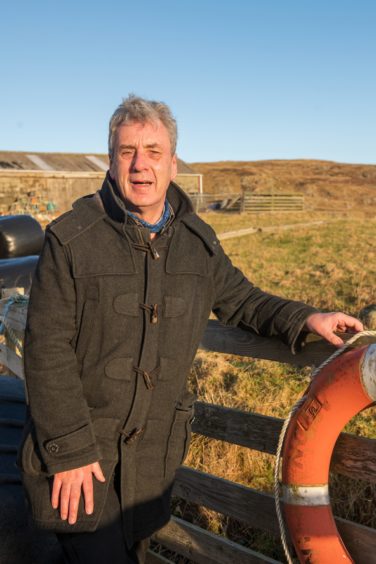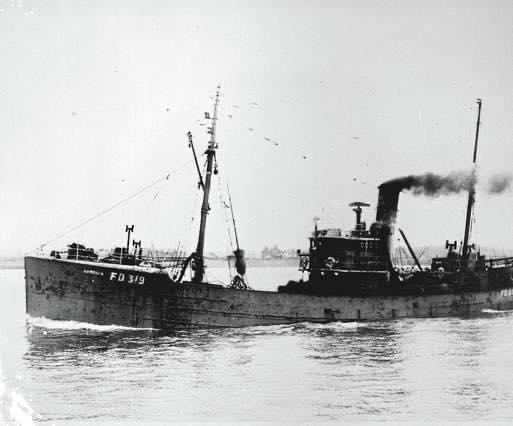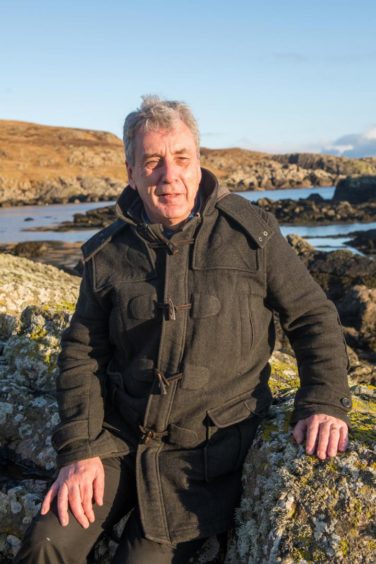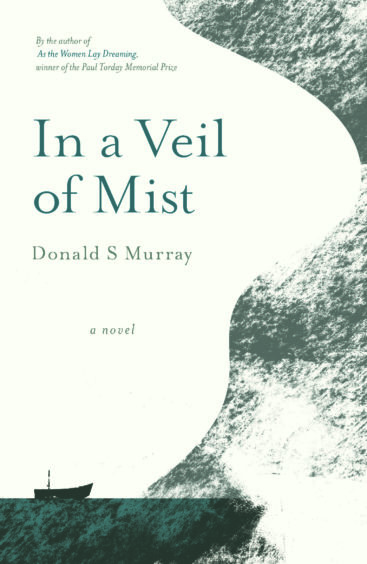It was one of the murkiest chapters from a time when politicians and scientists were seeking new weapons in the Cold War.
But the experiments weren’t carried out in a secret airbase in New Mexico or in hidden laboratories behind the Iron Curtain.
Instead the clandestine tests took place near a little village in the remote wilds of the outer Hebrides nearly 70 years ago.
Operation Cauldron was a series of warfare trials instigated by the British government in 1952, whereby boffins from Porton Down and the Royal Navy were involved in releasing biological agents, including pneumonic and bubonic plague, brucellosis and tularaemia and testing the effects of the agents on caged monkeys and guinea pigs.
While the covert mission was carried out in the north of Scotland, it was a joint Anglo-American Canadian programme, involving a US Navy Lieutenant Commander.
And now, an acclaimed Scottish author, Donald S Murray, has written a new work of fiction, In a Veil of Mist, which draws inspiration from the controversial incidents, which almost provoked an international incident and potential disaster.
More than 3,500 animals were used in the tests
Mr Murray has investigated how a wide range of experimental procedures were implemented at sea, off the coast of the Isle of Lewis in the Outer Hebrides, aboard a floating pontoon, supported by the ship Ben Lomond.
The hapless animals were placed in cages on the deck of the pontoon and dosed with biological agents dispersed either from a bomb suspended from a boom or a spray.
Once they had been exposed to the noxious substances, the creatures were taken aboard the Ben Lomond and those that died were dissected to determine the cause of death.
By the time the scientists had finished their work – which ultimately yielded little reward – no less than 3,492 guinea pigs and 83 monkeys had been used in the trials, which were initially – optimistically – judged to be a success.
However, just a year later, this decision was reversed, with the tests on plague bacteria being described as a “failure” and a statement was eventually released to the powers-that-be confirming “brucellosis has not increased its reputation as a dangerous agent”.
The ship which flirted with disaster
During the final experiment of the project, the English trawler Carella, with a crew of 18 men, ignored warnings to steer clear of the area and sailed through a cloud of bacteria (Yersinia pestis) on its return from a fishing trip to the waters around Iceland, causing concern about a plague outbreak among the wider public.
Incredibly, in these days when the world is grappling with a fatal pandemic, Carella was not stopped for disinfection or medical examination, but was kept under secret observation by a destroyer and a fisheries vessel for 21 days, and the ship’s radio communications were monitored for any kind of medical distress call.
The surveillance period included a period of shore-leave at Blackpool, during which the crew mixed with the residents of the town as usual.
None of them became ill, but the question remained: should innocent people have been left exposed in the first place?
Was this a case of the Butler did it?
The incident was dealt with at the highest levels of government in Westminster, going through the First Sea Lord to the Chancellor of the Exchequer Rab Butler, who was deputising for the absent Winston Churchill.
The event was successfully covered up at the time and, after the danger had passed, most of the documents relevant to the case were ordered to be burnt.
Even the crew of the Carella were unaware of the incident until the surviving members were approached by a BBC documentary team more than 50 years later.
And it is all the different moral, ethical, political and military aspects of the experiments which have been stitched together in Mr Murray’s vivid new novel.
Cauldron and Hesperus were the codewords of the operations
He has already written an award-wining book, As the Women Lay Dreaming, which recounted the tragedy of the Iolaire, which sank off the coast of Stornoway on New Year’s Day 1919, with the loss of more than 200 lives.
And, although he now lives in Shetland, he remains fascinated by the often forgotten stories from the past in the communities where he grew up.
He said: “In both 1952 and 1953, the UK government, in conjunction with their Canadian and United States equivalents, performed tests using biological weapons off the coastline of the Isle of Lewis, near the village of North Tolsta.
“These were called Operation Cauldron and Operation Hesperus; the last also occurring near the Flannan Isles.
“This top secret work involved the use of both aerosol droplets on both monkey and guinea pigs by those working on the ‘Ben Lomond’, a ship staffed largely by men from Porton Down who were researching its effects.
“This task was interrupted by the arrival of the Carella, a trawler from Fleetwood on the Lancashire coast.
“The crew ignored all warnings as they sailed through the area when these tests were occurring.
“Clearly, this caused a great deal of alarm for those involved in the experiments as they believed there was the possibility of the plague spreading to other areas of the UK.
“The Prime Minister’s office was informed of this possibility. But fortunately, due to flaws in the nature of the tests themselves, this did not occur.”
Clive Ponting helped bring the story to light
Mr Murray delved deep into the story and spoke to politicians who were able to shed some light on what happened all those years ago in a virtually deserted part of Scotland.
He added: “Much of the information was top secret. All we now know was revealed by the top civil servant, the late Clive Ponting, who was also responsible for the leaking of information on the sinking of the ‘Belgrano’ in the Falklands War.
“He gave information on the incident to the Observer in 1979.
This resulted in Donald Stewart, the MP for the Western Isles asking questions of Francis Pym, the Government minister who probably didn’t know any more than he did.
“The files – apart from the folder that Ponting accessed – had long been destroyed. Calum Macdonald MP also asked questions, but obtained no further information.”
Donald carried out exhaustive research for his book
The author knew he would have to travel extensively to unearth information about these decades-old events, especially with so many documents destroyed.
Yet he has not been deterred in gradually pulling the myriad strands together with assistance from others who wanted to pursue the truth.
He said: “The novel has been in my head for years. I spoke to Calum Macdonald about it in 1994, quizzing him to discover if he had found out anything new.
“I also read a short court report in the Stornoway Gazette about a member of staff on the Ben Lomond being arrested for various misdemeanours on the island.
“This sparked my imagination. This was one reason why I travelled to Gibraltar – which also plays a role in the novel – last year, acting as the Western Isles representative in the Inter Island Games.
“My thanks go to Comhairle nan Eileanan Siar for their help with this one. I also carried out a lot of research into the use of biological weapons not just in these islands but worldwide. That was very uncomfortable reading!
“The novel also features action in the north west of England, including Fleetwood, Liverpool and Sutton Oak and the research faculties that existed there at one time.
“It surprised me how contemporary much of the novel turned out to be. I had written a version of the most ‘up-to-date’ scene years ago.”
Many stories remain to be written in Western Isles lore
Donald Murray has a powerful imagination and a passion for imagery which has gained him plaudits across the literary world.
But he also has a keen interest in history and the attitude that genius is an infinite capacity for taking pains when it comes to digging behind duplicity and the sort of governmental jargon which disguises scandals and controversies.
And he isn’t about to stop creating new works in the months ahead, despite the problems posed by lockdown.
He said: “I have quite a few novels and other books about the Western Isles and various other islands still in my head, waiting to be written.
“I don’t think I’m unique in that and I’m working on two at the moment.
One is fiction; the other non-fiction.
This one was in so many ways easier to write than As The Women Lay Dreaming about the Iolaire disaster and its effect on the island.
“There was a lot of historical weight in that subject, an awareness that – in some people’s eyes at least – I was always going to get the tone and approach wrong.
“There was much more freedom in writing In a Veil of Mist. It mattered less as there were no deaths involved.
“Much about Operation Cauldron is always going to remain unknown. That gave me the license to make things up – which I did. That freedom also allowed me to pay homage to the many Gaelic songs and singers I had known in my youth within its pages.”
It is a compelling insight into a story which would nowadays spark outrage from different groups, including animal rights activists and supporters of open government.
But then, the normal rules didn’t apply on either side during the Cold War.
The new book will be published by Saraband in the spring.
